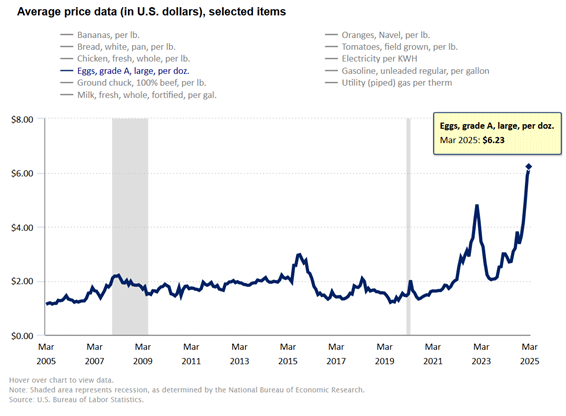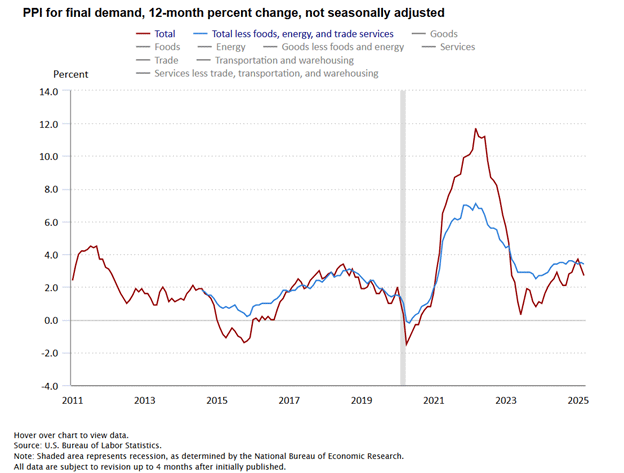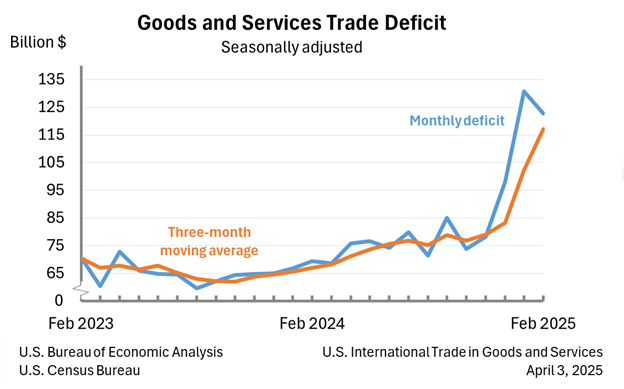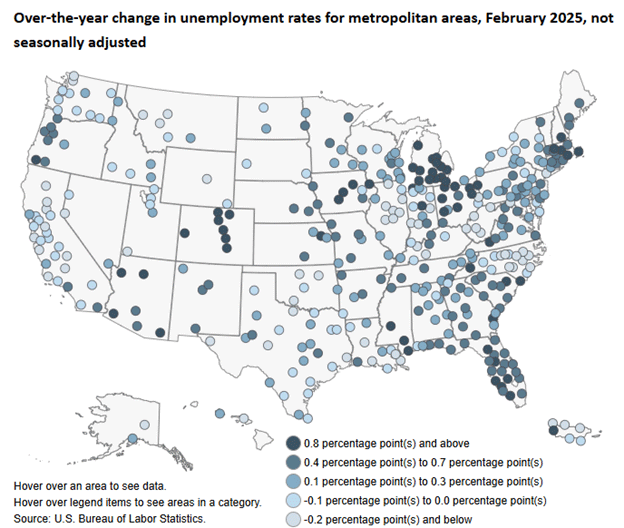March Jobs Report: Gains Hold as Inflation Cools
EBRC Research Staff
Current data releases as of 11 April 2025
The U.S. unemployment rate changed little in March at 4.2%, while total nonfarm payroll jobs increased by 228,000, according to the Bureau of Labor Statistics’ April 4th employment situation summary. Job gains occurred in health care (54,000), social assistance (24,000), retail trade (24,000), and transportation and warehousing (23,000). Federal government employment declined by 4,000 in March, following a loss of 11,000 jobs in February. Employment showed little change in other major industries. In March, average hourly earnings for all employees rose by 9 cents to $36.00. The average workweek for private nonfarm employees remained at 34.2 hours. This release also revised employment in January and February down by -14,000 and -34,000, respectively. -Delaney O’Kray-Murphy
The U.S. consumer price index for all items fell 0.1% over the month (seasonally adjusted) in March, after rising 0.2% the prior month. Consumer prices were up 2.4% over the year, down from a 2.8% increase in February. Prices for all items less food and energy were up 2.8% over the year, which was the slowest gain since March 2021. Energy prices were down over the year while food prices were up 3.0%. The retail price of eggs remained elevated in March, at $6.23 per dozen. The index for eggs was up 60.4% over the year in March. —George Hammond

U.S. producer prices for final demand decreased 0.4% in March (seasonally adjusted) after rising 0.1% in February. Over the year, final demand prices rose 2.7%, down from 3.2% in February. Final demand goods prices were up 0.9%. Energy prices were down 6.7% over the year (reflecting falling gas prices). In contrast, final demand services were up 3.6% in March. Prices for processed goods for intermediate demand were up 0.9% over the year, while prices for unprocessed goods for intermediate demand were up 7.1%. Unprocessed foodstuffs and feedstuffs prices increased 6.5% over the year in March but fell 7.5% from February. Ungraded chicken egg prices dropped 36.2% over the month in March. If sustained, consumer prices for eggs should begin to drop going forward. —George Hammond

The U.S. February goods and services trade deficit came in at $122.7 billion, down $8.0 billion from a revised $130.7 billion in January. February exports grew $8.0 billion to $278.5 billion, and imports fell $0.1 billion to $401.1 billion. The reduction in the deficit reflects a decrease in the goods deficit of $8.8 billion to $147.0 billion and a decrease in the services surplus of $0.8 billion to $24.3 billion. Year to date, the goods and services trade deficit increased 86.0%, or $117.1 billion, from the same period in 2024, with exports rising 4.6% and imports rising 21.4%. The largest surpluses, in billions, were with South and Central America ($4.8), Netherlands ($4.1), and the United Kingdom ($4.1), while the greatest deficits were with European Union ($30.9), China ($26.6), and Switzerland ($18.8). -Delaney O’Kray-Murphy

The February 2025 release of the Job Openings and Labor Turnover (JOLTS) report stated that the number of job openings in the U.S. changed little at 7.6 million, with a job openings rate of 4.5%. The number of job openings decreased in finance and insurance (-80,000). Nationally, the number of hires was unchanged at 5.4 million. There was a rate of 3.4% for February and this was the third consecutive month at this rate. The total number of separations in the nation was unchanged at 5.3 million, with a rate of 3.3%. The number of quits changed little at 3.2 million with a rate of 2.0%. The number of layoffs and discharges similarly changed little at 1.8 million or a rate of 1.1%. Layoffs and discharges increased in retail trade (+67,000), real estate and rental leasing (+24,000), and federal government (+18,000). There was a decrease in layoffs and discharges in transportation, warehousing, and utilities (-42,000). -Alex Jaeger
Most metropolitan areas in the nation had higher unemployment rates in February than a year earlier (255 out of 387) based on the U.S. Bureau of Labor Statistics metropolitan area employment report. This included all of Arizona’s metropolitan areas, with Yuma rising the most with a 1.8 percentage point change. Rapid City, SD, and Sioux Falls, SD-MN, had the lowest jobless rates for February, at 2.1% each, while El Centro, CA had the perennial high rate of 17.2%. Unemployment rates for Arizona metropolitan areas were 4.5% in Flagstaff, 4.9% in Lake Havasu City-Kingman, 3.6% in Phoenix, 3.9% in Prescott Valley-Prescott, 4.8% in Sierra Vista-Douglas, 4.0% in Tucson, and 10.7% in Yuma. Nationally, the unadjusted rate was 4.5% in February compared to 4.2% a year ago. -Valorie Rice

Occupational employment and wage data for 2024 are now available for the U.S., states, and metropolitan areas. The U.S. Bureau of Labor Statistics release highlighted production occupations, which represented 5.7% of total national employment, and made up 4.0% of Arizona’s total employment. This was far below the states with the highest concentration, which were Indiana at 11.3% and Wisconsin at 10.5%. Like the U.S., the largest production occupations in Arizona were miscellaneous assemblers and fabricators. The highest-paying production occupation in Arizona was power plant operators, at an annual average pay of $98,940, higher than the average pay nationally for power plant operators at $95,990. The highest-paying production occupation in the U.S. was nuclear power reactor operators at a $122,830 annual mean wage. Among the lowest-paying production occupations nationally and in Arizona were pressers, textile, garment, and related materials followed by laundry and dry-cleaning workers. Arizona workers in these occupations were paid a bit more than the U.S. Flagstaff was the metropolitan area with the highest concentration of production occupations in Arizona, at 4.7% while Sierra Vista had the lowest at 2.6%. The metropolitan area with the highest concentration nationally was Elkhart-Goshen, IN, at 32.8%. -Valorie Rice





